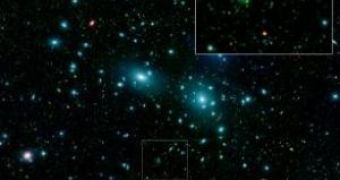A dwarf galaxy is a small galaxy composed of up to several billion stars, a small number compared to our own Milky Way's 200-400 billion stars. These small galaxies frequently orbit around larger galaxies, such as the Milky Way, the Andromeda Galaxy and the Triangulum Galaxy.
NASA's Spitzer Space Telescope has found more than a thousand previously unknown dwarf galaxies in a single giant cluster of galaxies, in a short amount of time.
Astronomers estimated that the dwarf galaxies play a crucial role in cosmic evolution, despite their diminutive sizes, being the first galaxies to form and providing building blocks for larger galaxies.
Standard theories of dark matter and the evolution of galaxies calculate that small galaxies should merge over time to form large ones, and that many of these undersized, unmerged galaxies should be visible today.
Theories predict about 100 times more dwarf galaxies than are actually observed. Possible explanations range from the suggestion that small galaxies somehow inhibit star formation, making them essentially invisible, to the prospect that they are surrounded by more unseen dark matter than first thought.
They are by far the most numerous galaxies in our Universe and are an important tracer of the large-scale structure of the cosmos. The team of astronomers that made the observations, led by Leigh Jenkins and Ann Hornschemeier, both at NASA Goddard Space Flight Center in Greenbelt, Md., used Spitzer to study the Coma cluster, an enormous congregation of galaxies 320 million light-years away in the constellation Coma.
Besides the hundreds of already known galaxies, the team found around 30,000 objects, a large fraction of which must be background galaxies. Complex calculations revealed that 1,200 of the 30,000 faint objects are dwarf galaxies in Coma.
"With Spitzer's superb capabilities, we have suddenly been able to detect thousands of faint galaxies that weren't seen before," says Jenkins.
"We're blowing away previous infrared surveys of nearby clusters," adds Hornschemeier. "Thanks to Spitzer, we can observe nearby clusters such as Coma very deeply in a short amount of time. The total observing time is comparable to just a few nights at a ground-based observatory."

 14 DAY TRIAL //
14 DAY TRIAL //